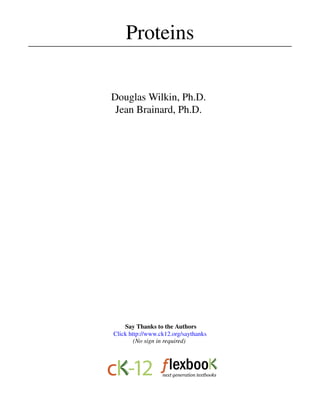
Proteins: Structure and Functions
- 1. Proteins Douglas Wilkin, Ph.D. Jean Brainard, Ph.D. Say Thanks to the Authors Click http://www.ck12.org/saythanks (No sign in required)
- 2. To access a customizable version of this book, as well as other interactive content, visit www.ck12.org CK-12 Foundation is a non-profit organization with a mission to reduce the cost of textbook materials for the K-12 market both in the U.S. and worldwide. Using an open-content, web-based collaborative model termed the FlexBook®, CK-12 intends to pioneer the generation and distribution of high-quality educational content that will serve both as core text as well as provide an adaptive environment for learning, powered through the FlexBook Platform®. Copyright © 2014 CK-12 Foundation, www.ck12.org The names “CK-12” and “CK12” and associated logos and the terms “FlexBook®” and “FlexBook Platform®” (collectively “CK-12 Marks”) are trademarks and service marks of CK-12 Foundation and are protected by federal, state, and international laws. Any form of reproduction of this book in any format or medium, in whole or in sections must include the referral attribution link http://www.ck12.org/saythanks (placed in a visible location) in addition to the following terms. Except as otherwise noted, all CK-12 Content (including CK-12 Curriculum Material) is made available to Users in accordance with the Creative Commons Attribution-Non-Commercial 3.0 Unported (CC BY-NC 3.0) License (http://creativecommons.org/ licenses/by-nc/3.0/), as amended and updated by Creative Com-mons from time to time (the “CC License”), which is incorporated herein by this reference. Complete terms can be found at http://www.ck12.org/terms. Printed: September 30, 2014 AUTHORS Douglas Wilkin, Ph.D. Jean Brainard, Ph.D.
- 3. www.ck12.org Chapter 1. Proteins CHAPTER 1 Proteins • Describe the composition of a protein. • Distinguish between the four levels of protein structure. • Summarize significant protein functions. You may have been told proteins are good for you. Do these look good to you? Proteins as food. To you, these may not look appetizing (or they might), but they do provide a nice supply of amino acids, the building blocks of proteins. Proteins have many important roles, from transporting, signaling, receiving, and catalyzing to storing, defending, and allowing for movement. Where do you get the amino acids needed so your cells can make their own proteins? If you cannot make it, you must eat it. Proteins A protein is an organic compound made up of small molecules called amino acids. There are 20 different amino acids commonly found in the proteins of living organisms. Small proteins may contain just a few hundred amino acids, whereas large proteins may contain thousands of amino acids. The largest known proteins are the titans, found in muscle, which are composed from almost 27,000 amino acids. Protein Structure When amino acids bind together, they form a long chain called a polypeptide. A protein consists of one or more polypeptide chains. A protein may have up to four levels of structure. The lowest level, a protein’s primary structure, is its sequence of amino acids. Higher levels of protein structure are described in Figure below. The complex structures of different proteins give them unique properties, which they need to carry out their various jobs in living 1
- 4. www.ck12.org FIGURE 1.1 General Structure of Amino Acids. This model shows the general structure of all amino acids. Only the side chain, R, varies from one amino acid to another. For example, in the amino acid glycine, the side chain is simply hydrogen (H). In glutamic acid, in contrast, the side chain is CH2CH2COOH. Variable side chains give amino acids different chemical properties. The order of amino acids, together with the properties of the amino acids, deter-mines the shape of the protein, and the shape of the protein determines the func-tion of the protein. KEY: H = hydrogen, N = nitrogen, C = carbon, O = oxygen, R = variable side chain organisms. You can learn more about protein structure by watching the animation at the following link: http://w ww.stolaf.edu/people/giannini/flashanimat/proteins/protein%20structure.swf . Proteins play many important roles in living things. Some proteins help cells keep their shape (structural proteins), some make up muscle tissues, and some transport items in and out of cells (transport proteins). Some proteins act as signals, and other proteins receive those signals. Enzymes are proteins that speed up chemical reactions in cells. Other proteins are antibodies, which bind to foreign substances such as bacteria and target them for destruction. Still other proteins carry messages or transport materials. For example, human red blood cells contain a protein called hemoglobin, which binds with oxygen. Hemoglobin allows the blood to carry oxygen from the lungs to cells throughout the body. A model of the hemoglobin molecule is shown in Figure above. 2
- 5. www.ck12.org Chapter 1. Proteins Proteins and Diet Proteins in the diet are necessary for life. Dietary proteins are broken down into their component amino acids when food is digested. Cells can then use the components to build new proteins. Humans are able to synthesize all but eight of the twenty common amino acids. These eight amino acids, called essential amino acids, must be consumed in foods. Like dietary carbohydrates and lipids, dietary proteins can also be broken down to provide cells with energy. Summary • Proteins are organic compounds made up of amino acids. • A protein may have up to four levels of structure. The complex structures of different proteins give them unique properties. • Enzymes are proteins that speed up biochemical reactions in cells. Antibodies are proteins that target pathogens for destruction. Review 1. Proteins are made out of ____________. 2. What determines the primary structure of a protein? 3. State two functions of proteins. 4. What are enzymes? 5. Describe the role of hemoglobin. References 1. User:YassineMrabet/Wikimedia Commons. A model of the general structure of amino acids. Public Domain 3